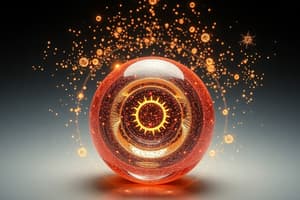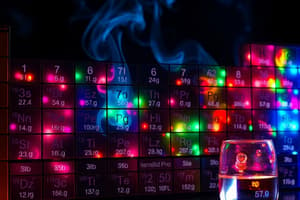Podcast
Questions and Answers
Which factor primarily dictates the arrangement of elements in the modern periodic table?
Which factor primarily dictates the arrangement of elements in the modern periodic table?
- Similar chemical properties
- Increasing atomic mass
- Increasing atomic number (correct)
- Electron affinity trends
Which of the following statements accurately describes the periodic trend of atomic radii?
Which of the following statements accurately describes the periodic trend of atomic radii?
- Atomic radii generally increase across a period and increase down a group.
- Atomic radii generally decrease across a period and increase down a group. (correct)
- Atomic radii generally decrease across a period and decrease down a group.
- Atomic radii generally increase across a period and decrease down a group.
Consider the elements oxygen, fluorine, and sulfur. How does the ionization energy change among these elements?
Consider the elements oxygen, fluorine, and sulfur. How does the ionization energy change among these elements?
- Ionization energy decreases from oxygen to fluorine, and increases from oxygen to sulfur.
- Ionization energy increases from oxygen to fluorine, and increases from oxygen to sulfur.
- Ionization energy decreases from oxygen to fluorine, and decreases from oxygen to sulfur.
- Ionization energy increases from oxygen to fluorine, and decreases from oxygen to sulfur. (correct)
Why is the first ionization energy of nitrogen ($N$) greater than that of oxygen ($O$)?
Why is the first ionization energy of nitrogen ($N$) greater than that of oxygen ($O$)?
What is the underlying reason for the trend of increasing electronegativity across a period in the periodic table?
What is the underlying reason for the trend of increasing electronegativity across a period in the periodic table?
Which of the following elements is expected to have the highest electronegativity?
Which of the following elements is expected to have the highest electronegativity?
Considering the concept of 'periodicity', which statement best describes its significance in the periodic table?
Considering the concept of 'periodicity', which statement best describes its significance in the periodic table?
How does the shielding effect influence ionization energy trends within the periodic table?
How does the shielding effect influence ionization energy trends within the periodic table?
An experiment requires a precise measurement of 5.00 g of a substance, but due to instrument error, the measured value is consistently 5.20 g. Determine the absolute and relative errors.
An experiment requires a precise measurement of 5.00 g of a substance, but due to instrument error, the measured value is consistently 5.20 g. Determine the absolute and relative errors.
In scientific measurements, what is the key difference between accuracy and precision?
In scientific measurements, what is the key difference between accuracy and precision?
A student performs an experiment to determine the density of a metal. The true density is 7.87 g/cm³. The student performs four trials and obtains the following densities: 7.85 g/cm³, 7.86 g/cm³, 7.84 g/cm³, and 7.85 g/cm³. How would you describe the student's results?
A student performs an experiment to determine the density of a metal. The true density is 7.87 g/cm³. The student performs four trials and obtains the following densities: 7.85 g/cm³, 7.86 g/cm³, 7.84 g/cm³, and 7.85 g/cm³. How would you describe the student's results?
When balancing chemical equations, why is it impermissible to alter the subscripts within the chemical formulas of the reactants or products?
When balancing chemical equations, why is it impermissible to alter the subscripts within the chemical formulas of the reactants or products?
Which of the following is a balanced chemical equation?
Which of the following is a balanced chemical equation?
In the reaction $2N_2O_5(g) \rightarrow 2N_2O_4(g) + O_2(g)$, if 4 moles of $N_2O_5$ completely react, how many moles of $O_2$ are produced?
In the reaction $2N_2O_5(g) \rightarrow 2N_2O_4(g) + O_2(g)$, if 4 moles of $N_2O_5$ completely react, how many moles of $O_2$ are produced?
Consider the reaction: $C_3H_8(g) + 5O_2(g) \rightarrow 3CO_2(g) + 4H_2O(g)$. If 22.0 g of $C_3H_8$ react with excess $O_2$, how many grams of $CO_2$ will be produced?
Consider the reaction: $C_3H_8(g) + 5O_2(g) \rightarrow 3CO_2(g) + 4H_2O(g)$. If 22.0 g of $C_3H_8$ react with excess $O_2$, how many grams of $CO_2$ will be produced?
Why is the concept of a limiting reagent critical in stoichiometry?
Why is the concept of a limiting reagent critical in stoichiometry?
If 10.0 g of $H_2$ reacts with 70.0 g of $O_2$ to produce water, and given the balanced equation $2H_2 + O_2 \rightarrow 2H_2O$, identify the limiting reagent.
If 10.0 g of $H_2$ reacts with 70.0 g of $O_2$ to produce water, and given the balanced equation $2H_2 + O_2 \rightarrow 2H_2O$, identify the limiting reagent.
How does the theoretical yield differ from the percentage yield?
How does the theoretical yield differ from the percentage yield?
In a chemical reaction, the theoretical yield of a product is calculated to be 25.0 g. If the actual yield obtained in the experiment is 20.0 g, what is the percentage yield?
In a chemical reaction, the theoretical yield of a product is calculated to be 25.0 g. If the actual yield obtained in the experiment is 20.0 g, what is the percentage yield?
Which statement accurately describes the rules for assigning oxidation numbers?
Which statement accurately describes the rules for assigning oxidation numbers?
In the following reaction, $2KClO_3(s) \rightarrow 2KCl(s) + 3O_2(g)$, if you start with 3.00 g of $KClO_3$ , what is the theoretical yield of $O_2$?
In the following reaction, $2KClO_3(s) \rightarrow 2KCl(s) + 3O_2(g)$, if you start with 3.00 g of $KClO_3$ , what is the theoretical yield of $O_2$?
How does the presence of isotopes affect the calculation of average atomic mass?
How does the presence of isotopes affect the calculation of average atomic mass?
A sample of element X consists of 69.17% isotope $^{63}X$ (mass 62.93 u) and 30.83% isotope $^{65}X$ (mass 64.93 u). Calculate the average atomic mass of element X.
A sample of element X consists of 69.17% isotope $^{63}X$ (mass 62.93 u) and 30.83% isotope $^{65}X$ (mass 64.93 u). Calculate the average atomic mass of element X.
What is the significance of Avogadro's number in the context of chemical calculations?
What is the significance of Avogadro's number in the context of chemical calculations?
How many hydrogen atoms are present in 2.5 moles of $C_6H_{12}O_6$?
How many hydrogen atoms are present in 2.5 moles of $C_6H_{12}O_6$?
What is the molar mass of a compound?
What is the molar mass of a compound?
What mass of NaCl is contained in 250.0 mL of a 0.200 M NaCl solution?
What mass of NaCl is contained in 250.0 mL of a 0.200 M NaCl solution?
Why is percentage composition a useful concept in chemistry?
Why is percentage composition a useful concept in chemistry?
Flashcards
Periodic Table
Periodic Table
A tabular arrangement of elements by increasing atomic number.
Periodicity
Periodicity
Recurring trends observed in element properties.
Atomic Radius
Atomic Radius
Half the distance between two nuclei of a homo diatomic molecule.
Ionization Energy
Ionization Energy
Signup and view all the flashcards
First Ionization Energy
First Ionization Energy
Signup and view all the flashcards
Electronegativity
Electronegativity
Signup and view all the flashcards
Errors
Errors
Signup and view all the flashcards
Absolute Error
Absolute Error
Signup and view all the flashcards
Relative Error
Relative Error
Signup and view all the flashcards
Accuracy
Accuracy
Signup and view all the flashcards
Precision
Precision
Signup and view all the flashcards
Stoichiometry
Stoichiometry
Signup and view all the flashcards
Relative Atomic Mass
Relative Atomic Mass
Signup and view all the flashcards
Average Atomic Mass:
Average Atomic Mass:
Signup and view all the flashcards
Avogadro's Number
Avogadro's Number
Signup and view all the flashcards
Mole
Mole
Signup and view all the flashcards
Molar Mass
Molar Mass
Signup and view all the flashcards
Balancing Chemical Equations
Balancing Chemical Equations
Signup and view all the flashcards
Limiting Reagent
Limiting Reagent
Signup and view all the flashcards
Yield
Yield
Signup and view all the flashcards
Theoretical Yield
Theoretical Yield
Signup and view all the flashcards
Actual Yield
Actual Yield
Signup and view all the flashcards
Percentage Yield
Percentage Yield
Signup and view all the flashcards
Study Notes
- Course FSC112/CHM 101 topics include trends in atomic radii, ionization energies, electronegativity, chemical equations, stoichiometry, calculations based on equations, and the limiting reactant concept.
Periodic Table
- The layout is a tabular arrangement of elements by increasing atomic number.
- Periodicity refers to the recurrence of similar properties at regular intervals with elements that have increasing atomic numbers.
- Main group and transition elements are sometimes labeled as A and B subgroups.
- s-block and p-block groups numbered as I to VII as well as zero.
- d-block and f-block elements also exist.
- 19th-century chemists like Newland, Lother, and Mendeleev contributed to the modern periodic table.
- Elements are arranged by increasing atomic number.
- Elements in the same group (vertical column) have similar properties and the same number of valence shell electrons.
- Lithium (Li) has the electron configuration [He] 2s¹.
- Sodium (Na) has the electron configuration [Ne] 3s¹.
- Potassium (K) has the electron configuration [Ar] 4s¹.
- Rubidium (Rb) has the electron configuration [Kr] 5s¹.
- Elements in the same period (horizontal row) have progressively different physical and chemical properties as electrons and protons are added.
- Lithium (Li): 3, [He]2s¹
- Beryllium (Be): 4, [He]2s²
- Boron (B): 5, [He] 2s²2p¹
- Carbon (C): 6, [He]2s²2p²
- Ground state electron configurations describe the electron arrangement outermost energy level.
Periodicity
- Periodicity involves recurring elemental properties due to regular, predictable variations in atomic structure.
- Periodic properties depend on electronic configuration and repeat at certain intervals within groups or periods.
- Gradual changes in physical properties are shown by elements across a period or down a group.
- Properties include atomic radius, ionic radius, ionization energy, electron affinity, and electronegativity.
Atomic Radius
- Half the distance between the nuclei of two atoms in a homodiatomic molecule is the atomic radius.
- Atomic radius decreases across a period due to increased positive charge from more protons in the nucleus.
- A greater positive charge pulls added electrons closer to the nucleus.
Trends in Atomic Radii
- Energy level of the valence electron, nuclear charge, and shielding effect which influence it.
- Higher energy levels result in valence electrons that are further from the nucleus.
- Distance increases by energy level: 1 < 2 < 3 < 4 < 5 < 6 < 7
- Increased nuclear charge pulls electrons closer to the nucleus.
- Nuclear charge equals atomic number.
- A higher atomic number reduces size.
- Shielding by inner electrons screens outer electrons from the nucleus.
- Greater shielding leads to larger atomic size due to electron repulsion.
Ionization Energy (IE)
- The energy (kJ/mole) needed to remove the most loosely bound electron from an isolated gaseous atom to form a positive gaseous ion.
- Supplying a small amount of energy promotes electrons to a higher energy level.
- A sufficient amount of energy completely removes the electron.
- First ionization energy is the minimum energy needed to remove the first electron from a gaseous atom in its ground state, forming a gaseous ion.
- Subsequent ionization energies(I₂, I₃, etc.) refer to the energy to remove the second, third, and so on electrons.
- Each subsequent IE is progressively greater (I₁ < I₂ < I₃).
- Ionization energy is always endothermic, or requires energy to be added to the atom.
- IE reduces if the size of the atom increases.
- Ionization energy and atomic radius have an inverse relationship.
- Larger atoms have smaller ionization energies and larger atomic radii.
- Nuclear charge, shielding effect, radius and sublevel impact IE.
- Larger nuclear charge increases ionization energy.
- Greater shielding effect lessens ionization energy.
- Larger distance between nucleus and outer electrons lowers ionization energy.
- Removing an electron from a full or half-full sublevel requires extra energy.
- Full and half full orbitals are more stable.
- Filled ns² and np⁶ orbitals along with half-filled np³ orbitals are more stable.
- Higher ionization energy than expected is seen because the orbital resists losing stability
- Group trends are based on first, second, and third ionization energies.
- The first IE decreases down a group as atomic radius increases and shielding effect increases.
- In the same period, atoms have valence electrons in the same energy level and shielding.
- Nuclear charge increases across the period.
- IE generally increases from left to right but exceptions occur with full/half full orbitals.
- In the second and third rows, successive ionization energies rise as electrons are removed from valence orbitals (2s or 2p & 3s or 3p).
- A sharp increase is seen in ionization energy occurs when electrons are taken from filled core levels.
- First ionization energies increase across the periodic table as valence electrons do not screen each other, and increase the effective nuclear charge across the row.
- Valence electrons are more strongly attracted to the nucleus and this reduces atomic size and increases ionization energy.
- Changes seen in the second, third, fourth, fifth, and sixth row, s and p block ionization energies increase across each row from left to right.
- First ionization energies fall down a group.
- Filled inner shells effectively screen valence electrons.
- The small increase is due to an effective nuclear charge.
- Atoms become larger as they gain electrons.
- Valence electrons further from the nucleus are less tightly bound, lessening ionization energies.
- A larger atomic radius has a lower ionization energy.
- Elements forming positive ions most easily are in the lower-left corner having the lowest ionization energies.
- The elements that resist ionization are in the upper-right corner.
- Ionization energies rise diagonally from the lower-left to upper-right.
- Minor deviations are due to stable electronic configurations called pseudo-inert gas configuration.
Electronegativity
- Electronegativity measures an atom's ability to attract electrons within a molecule.
- Linus Pauling (1901-1994) first proposed the concept and later won a Nobel Prize.
- Metals have a low tendency to attract electrons and a high tendency to release them.
- Non-metals have a high tendency to attract electrons and a low tendency to release them.
- Smaller atoms attract electrons more strongly and are more electronegative.
- Atoms with nearly filled electron shells have higher electronegativity that those with sparsely filled shells.
- A covalent bond predominates between two atoms with similar electronegativities.
- A large electronegativity difference leads to a bond with high polar character.
- In a group, larger atoms increase in size, and valence electrons move further from the nucleus.
- This increases shielding from nuclear charge.
- The lessened attraction of the nucleus for valence electrons reduces electronegativity down the group.
- The sizes of atoms decrease across a period, retaining the same energy levels.
- Attraction of the nucleus for valence electrons increases.
- Electronegativity rises left to right across the period
- Fluorine (F) is the highest, most electronegative element.
Chemical Equations
- Shorthand descriptions the chemical reactions
- Symbols and formulas represent the elements and compounds, for example: CH₄ + 2O₂ → CO₂ + 2H₂O.
- Reactants CH₄ and O₂ are on the left side of the arrow, and products CO₂ and 2H₂O are on the right.
- Atoms are rearranged, bonds have been broken, and new bonds have been formed.
- An equation must be balanced from the same number of each type of atom on both the product and reactant side.
- Balancing chemical equations ensures the concept is upheld by ensuring there is an equal number of atoms of each element on both sides of the equation.
- Balances change coefficients, not subscripts to preserve the identities of reactants and products.
- Balancing is usually done by inspecting the equation, and is a trial and error process.
- Complex molecules with the molecule with the greatest number of atoms are started with.
Stoichiometric Calculations
- The equation must be balanced before performing any stoichiometric calculation.
- For the equation, C₃H₈(g) + 5O₂(g) → 3CO₂(g) + 4H₂O(g)
- 1 mole of C₃H₈ reacts with 5 moles of O₂ to produce 3 moles of CO₂ and 4 moles of H₂O
Limiting Reagent
- It is completely consumed during a chemical reaction. The amount of product formed is limited by it.
- The stoichiometry of reactants must be known.
- For example, equation 2Bd + 1 egg → Bd₂egg -Toast bread requires 2 slices of bread (Bd) and 1 egg.
- If the reactant has 20 slices of bread and 12 eggs, the bread is limiting
Percentage Yield
- Mass of product formed in a chemical reaction
- Percent yield is the actual yield ratio to the theoretical yield
- The amount of a formed product when the limiting reactant yield is completely consumed, is called the theoretical yield.
- The actual yield is what you actually get
- Cases where actual yields are not the same a theoretical
- Yield is determined by calculating the percentage. Actual yield divided by the theoretical yield times 100%. When the actual equals theoretical, the reaction process is a stoichiometric process.
Studying That Suits You
Use AI to generate personalized quizzes and flashcards to suit your learning preferences.




